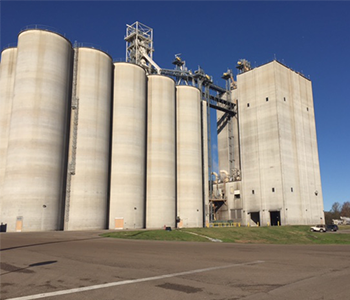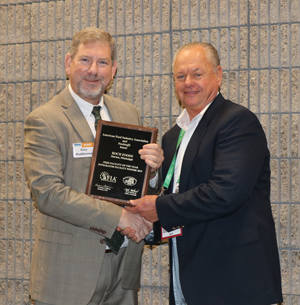
Written by: Guest | January 31, 2020

Sarah Muirhead
Editor, Feedstuffs
“A clean work area is a safe work area.” That is the messaging prominently displayed at the Koch Farms mill located in Morton, Miss., and, to mill manager Frank Garczynski those aren’t merely words. A clean facility and a safe work environment go hand in hand and are the center of his team’s daily mission.
The Morton mill produces nearly 800,000 tons of feed per year. It all goes to the poultry integrator’s farms located in the surrounding region.
Koch Farms is part of Koch Foods, a food processor and distributor based in Park Ridge, Ill., that is considered among the largest private companies in the U.S. Started as a one-room operation in 1985, Koch Foods is today considered one of the nation’s largest vertically integrated poultry producers, with locations across Alabama, Georgia, Illinois, Mississippi, Ohio and Tennessee.
The poultry integrator kills 2 million large and small chickens in the region each week, much of which are fed from its feed mill located in Morton, Miss. “We have approximately 11 million birds on feed all the time. Quality and output are essential,” Garczynski said.
The Morton facility is the American Feed Industry Assn./Feedstuffs Feed Facility of the Year as well as winner for the Integrator Category for 2019, repeating its similar category win for 2018.
Koch’s Morton mill, built in 2009 runs three production shifts each business day and produces about 125 semi-truck loads of feed per day.
The Morton mill is one of five mills in the Koch Foods system. It provides feed for all of the company's birds in Mississippi and runs Monday through Friday, with the exception of holidays. On Thanksgiving, the staff gets off for dinner but then starts production again on the second shift. The mill doesn't operate on Christmas Eve but does open late morning on Christmas Day. On any major holiday that the mill is open, Koch offers a meal to those who have to work.

One safety precaution taken when the mill was constructed was to keep the mill's legs out of the tower so the tower's integrity would not be jeopardized in the unlikely event of an explosion.
The mill also has a built-in vacuum system for cleaning. That system has been upgraded in the past year to allow for even more effective cleanups. Garczynski said the new vacuum system is available to all levels of the facility and allows the team to just carry the hose from area to area and plug it in. With a 30 horse motor, it really does a great job of getting up the dust, he said.
Cleanliness is important not only from a safety and quality standpoint, but it also helps with employee morale and retention, Garczynski said. He noted, too, that the facility is often visited by the Koch management team and potential and existing customers.
A safety meeting is held monthly is also a communication event, with formula changes explained, ideas exchanged and any other important issue that needs to be known discussion between the three shifts.
The facility’s safety committee is made up of employees plus the assistant manager and meets regularly. More formally in 2019 than in the past, two mill employees now attend a monthly live safety meeting at the hatchery to represent the mill. Garczynski said he attends a monthly complex safety meeting of all production facilities.
The Morton mill has worked 526,875 hours as of Nov. 15, 2019, without a lost time accident. The last lost time incident at the mill was July 1, 2014. The mill is considered in the top 5% of individual mill capacities worldwide, and it is all done in just five days a week.
A significant capital improvement project at the Morton facility during 2019 has been the addition of a maintenance parts/equipment storage building. The facility has upwards of 325 grouped areas of equipment in its parts management system. Garczynski explained that they can’t risk downtime at the mill as it can have significant ramifications throughout the rest of the production system. The new 70x40 maintenance parts/equipment storage building is where the parts are inventoried and stored to allow for easy access when needed. A Lean Management influenced 6-S organization (sort; set in order; shine; standardize; sustain; & safety) was used to lay out building contents.
Prior to the new maintenance/parts building, Garczynski said, organization was nearly impossible and cleanliness in that part of the facility was a struggle.
“It was very difficult to lay hands on, or know what parts were accessible quickly,” Garczynski said. He estimates there is about a million dollars of spare critical parts on hand.
On the live product side of the business, Garczynski said the company achieves some of the best feed conversions in the industry. In fact, its cost of production per pound of meat is considered to be in the top 5%.

The Morton mill operates with 18 production employees, six maintenance employees, four clerical employees, three supervisory employees and 12 truck drivers. In addition to its own fleet of trucks, the mill relies on a dedicated contractor fleet.
The fully automated areas of the mill are receiving, grain processing, batching, pelleting, and bulk loadout. A 100-car corn train can be unloaded at the mill in 12-14 hours. A 100-ton soybean meal car can be unloaded in 15 minutes in the winter. The facility has a scale built directly into its rail line so individual car weights can be recorded and billing adjusted as necessary.
The mill has six mixing scales. A Hays & Stolz 10-ton double-shaft mixer with an average mixing time of 100 seconds allows for 420 tons to be produced per hour. Three CPM pellet mills with double 16 ft. conditioners allow for the production of 225 tons per hour. Three Geelen counter flow pellet coolers and two pairs of crumble rolls round out the process.
Comments See our policy on comments